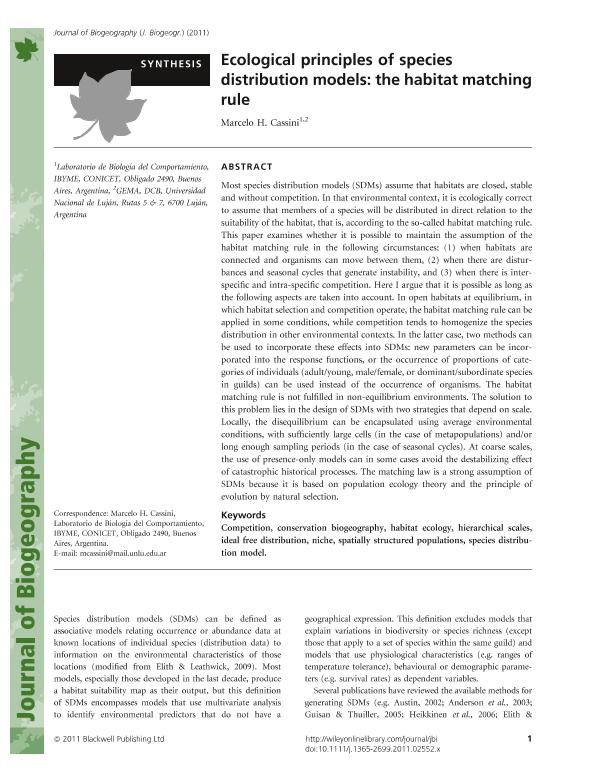Mostrar el registro sencillo del ítem
dc.contributor.author
Cassini, Marcelo Hernan

dc.date.available
2016-12-28T14:56:04Z
dc.date.issued
2011-10
dc.identifier.citation
Cassini, Marcelo Hernan; Ecological principles of species distribution models: the habitat matching law; Wiley; Journal Of Biogeography; 38; 10-2011; 2057-2065
dc.identifier.issn
0305-0270
dc.identifier.uri
http://hdl.handle.net/11336/10414
dc.description.abstract
Most species distribution models (SDMs) assume that habitats are closed, stable and without competition. In that environmental context, it is ecologically correct to assume that members of a species will be distributed in direct relation to the suitability of the habitat, that is, according to the so-called habitat matching rule. This paper examines whether it is possible to maintain the assumption of the habitat matching rule in the following circumstances: (1) when habitats are connected and organisms can move between them, (2) when there are disturbances and seasonal cycles that generate instability, and (3) when there is interspecific and intra-specific competition. Here I argue that it is possible as long as the following aspects are taken into account. In open habitats at equilibrium, in which habitat selection and competition operate, the habitat matching rule can be applied in some conditions, while competition tends to homogenize the species distribution in other environmental contexts. In the latter case, two methods can be used to incorporate these effects into SDMs: new parameters can be incorporated into the response functions, or the occurrence of proportions of categories of individuals (adult/young, male/female, or dominant/subordinate species in guilds) can be used instead of the occurrence of organisms. The habitat matching rule is not fulfilled in non-equilibrium environments. The solution to this problem lies in the design of SDMs with two strategies that depend on scale. Locally, the disequilibrium can be encapsulated using average environmental conditions, with sufficiently large cells (in the case of metapopulations) and/or long enough sampling periods (in the case of seasonal cycles). At coarse scales, the use of presence-only models can in some cases avoid the destabilizing effect of catastrophic historical processes. The matching law is a strong assumption of SDMs because it is based on population ecology theory and the principle of evolution by natural selection.
dc.format
application/pdf
dc.language.iso
eng
dc.publisher
Wiley

dc.rights
info:eu-repo/semantics/openAccess
dc.rights.uri
https://creativecommons.org/licenses/by-nc-sa/2.5/ar/
dc.subject
Competition
dc.subject
Conservation Biogeography
dc.subject
Habitat Ecology
dc.subject
Hierachical Scales
dc.subject
Species Distribution Model
dc.subject.classification
Ecología

dc.subject.classification
Ciencias Biológicas

dc.subject.classification
CIENCIAS NATURALES Y EXACTAS

dc.title
Ecological principles of species distribution models: the habitat matching law
dc.type
info:eu-repo/semantics/article
dc.type
info:ar-repo/semantics/artículo
dc.type
info:eu-repo/semantics/publishedVersion
dc.date.updated
2016-12-27T20:13:08Z
dc.identifier.eissn
1365-2699
dc.journal.volume
38
dc.journal.pagination
2057-2065
dc.journal.pais
Reino Unido

dc.journal.ciudad
Londres
dc.description.fil
Fil: Cassini, Marcelo Hernan. Universidad de Luján. GEMA; Argentina. Consejo Nacional de Investigaciones Científicas y Técnicas. Instituto de Biología y Medicina Experimental (i); Argentina
dc.journal.title
Journal Of Biogeography

dc.relation.alternativeid
info:eu-repo/semantics/altIdentifier/url/http://onlinelibrary.wiley.com/doi/10.1111/j.1365-2699.2011.02552.x/abstract
dc.relation.alternativeid
info:eu-repo/semantics/altIdentifier/doi/http://dx.doi.org/10.1111/j.1365-2699.2011.02552.x
Archivos asociados
